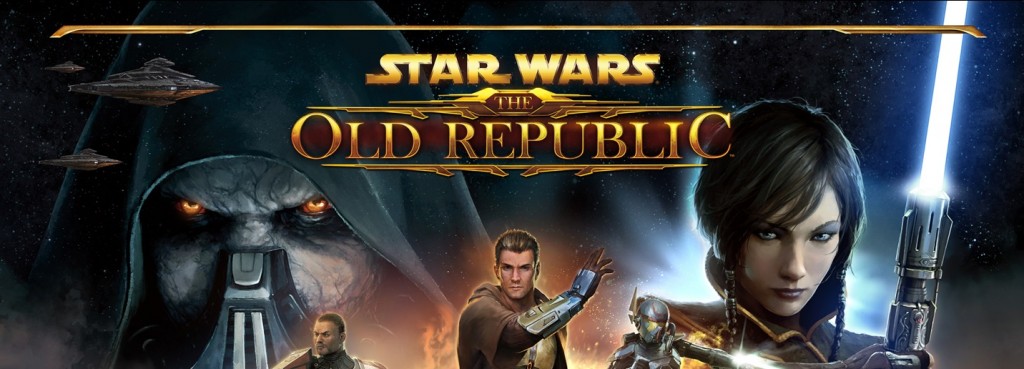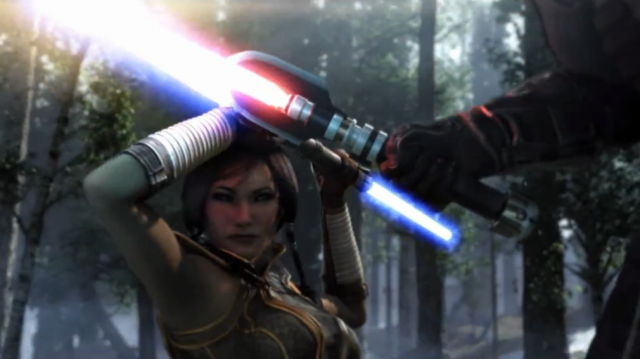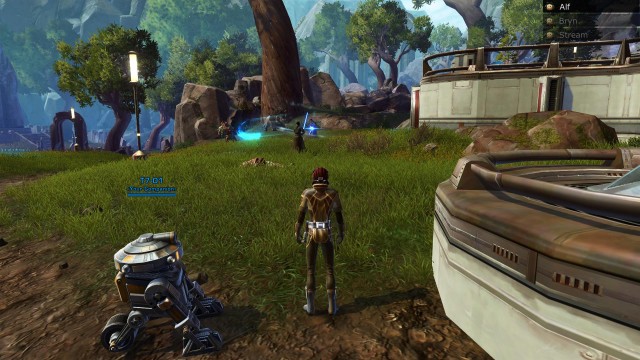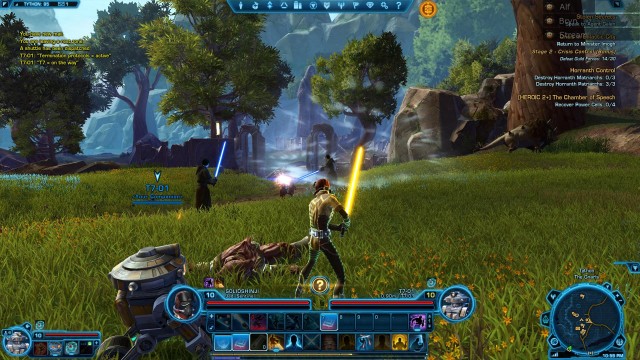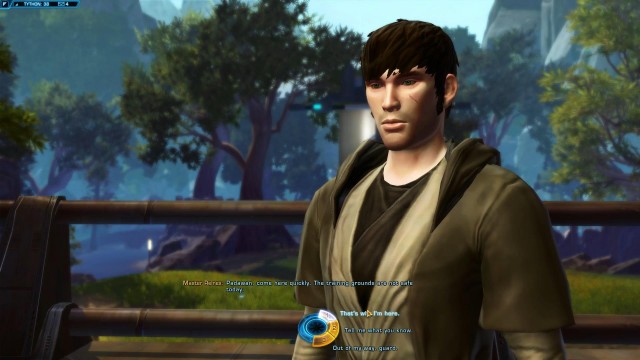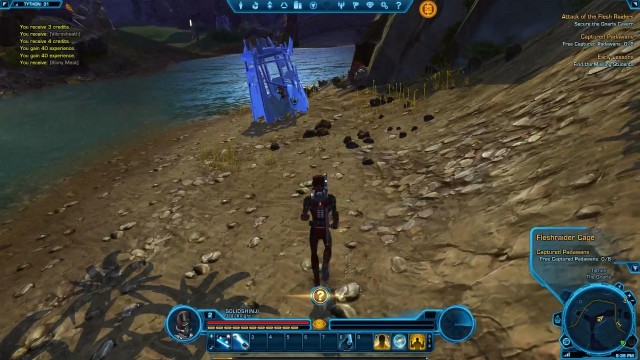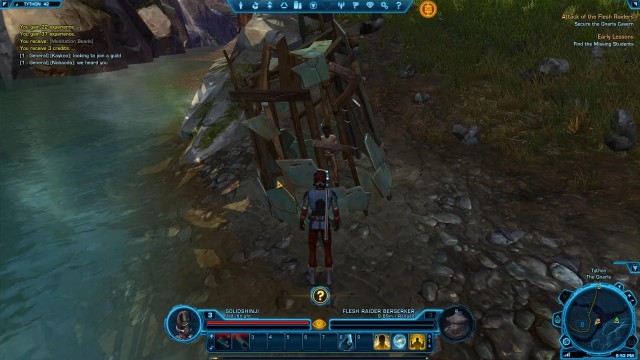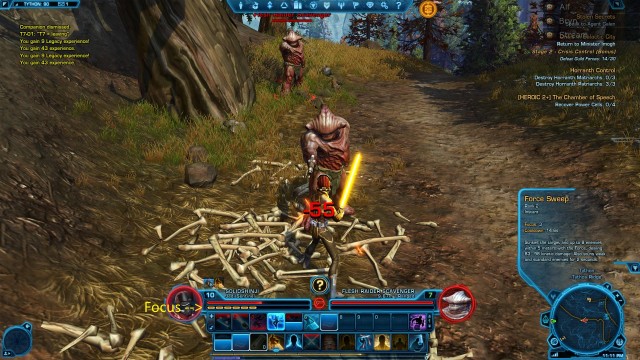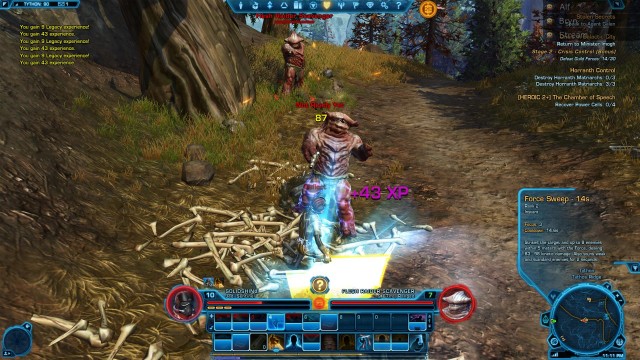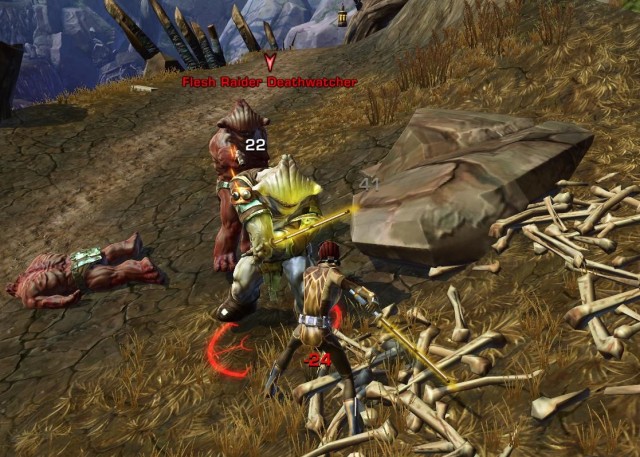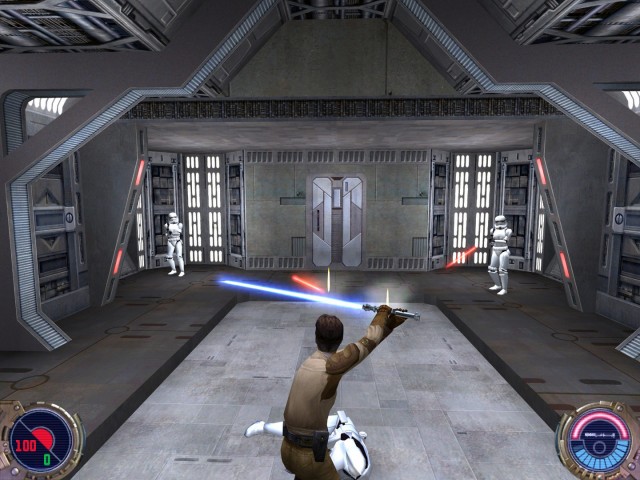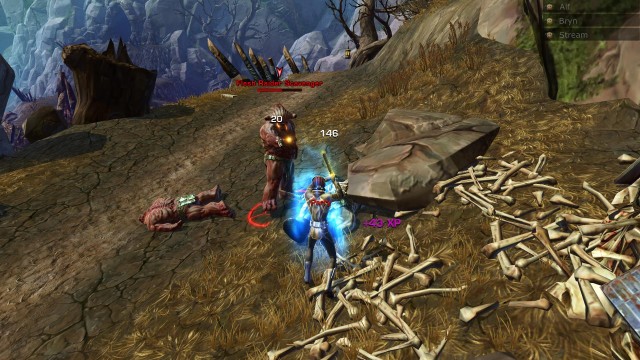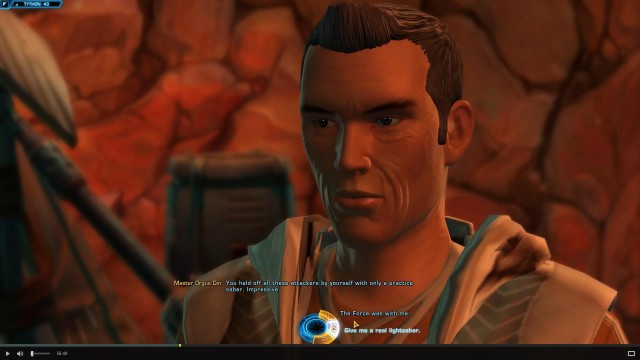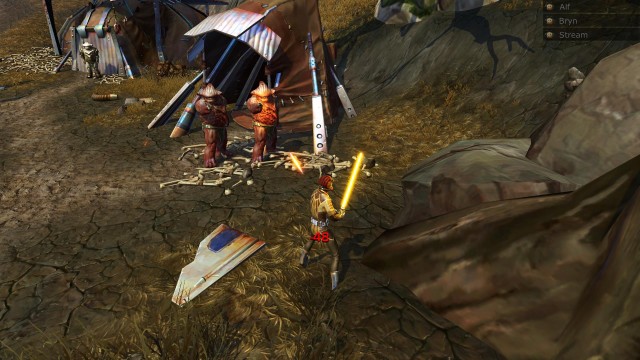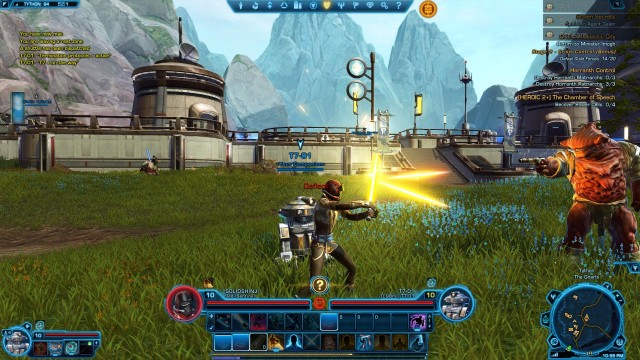To say that Star Wars: The Old Republic (SWTOR) was a highly anticipated game would be more than a bit of an understatement, given incredible amount of hype that predated the game’s launch.
Apart from the Star Wars license – one of the oldest and incredibly popular IPs on the market today, SWTOR also came on the heels of two quite successful, critically acclaimed games — the Knights of the Old Republic (KOTOR) series, a set of surprisingly story-centric Star Wars RPGs that provided a uniquely enjoyable experience quite unlike anything fans of the series had ever seen before.
Immediately after KOTOR II, speculation was already rife regarding the next installment in the series, with rumors already being circulating regarding the plot, characters, and more. Then came the official announcement: instead of KOTOR III, we would get something bold, something new, something unlike we’d ever seen before — a truly story based MMORPG, fusing the best parts of the MMO and RPG experience.
While some were excited by this, others were quite disappointed in the news, asking if a singleplayer RPG would be made for KOTOR III anyways.
The developers responded to this with the lofty claim that SWTOR would be better – and more than – KOTOR III – that it would essentially be “KOTOR 3-9”, given the multi-threaded storylines of each faction.
It all sounded incredibly ambitious, especially for a team that had never put together a MMO before. But then, there were rumors about the sheer amount of cash being thrown around. With $400 million going into the game, how could the quality be anything but excellent? After all, with those kinds of resources being thrown at development, you could have almost any tool – hell, any team, you wanted. Everyone, from tech pundits down to the average gamer was asking if this would be the game to finally knock World of Warcraft from its pedestal?
Indeed, the hype was so big that the story of The Old Republic (no doubt thanks to the efforts of well-paid PR staff) broke into the mainstream media, with the New York Times, Wall Street Journal, Forbes, and more openly speculating on the future of this new, strong investment that EA was putting out into the market.
With this much money thrown around, could EA and Bioware truly manage to pull a game together that would revolutionize MMO’s forever? Yes, many thought that the developer’s claims were somewhat exaggerated – after all, when weren’t they? – but few doubted that we would see an MMO who would be in the top 3 for quite a few years, and at least give WoW a run for its money.
And to fan the hype, initial reviews came back as extremely positive, with the average score among reviewers being an 8.5 out of 10 – staggeringly high when a “good” game was rated at 7 out of 10.
…and then we got the game.
Subscriber counts rose quickly, initially giving credence to the WoW killer speculation, but after merely one month on the market, growth slowed and then stopped altogether. When asked why, gamers cited a wide variety of complaints from technical issues to game design to badly thought out stories – in short, everything that $400 million should have been able to take care of, but somehow hadn’t.
By five months in, the game was hemorrhaging subscribers, with the team deciding to drop the subscription system and go Free-to-Play soon after, though of course, this went unannounced until a year post-release.
Unsurprisingly, this was a sign that most observers took as Bioware throwing in the towel and admitting defeat. And while SWTOR currently earns somewhere close to $150 million dollars a year, it is still considered a great disappointment for EA and a sign that investing large sums of money in games is a risky endeavor with an uncertain payoff.
So why did this happen?
To understand some of the negative reactions to the game, we both decided to play simultaneously through the early sections of this MMO – up to level 10 – as a Free-to-Play player, and see what we experienced. Our goal was to see what a player’s initial reaction would be to the game, and to see if we could grasp why players would stop playing the game after just one month.
As it turned out, we wanted to stop after one day, but valiantly kept at it so we could reach the goal we set – reaching level 10, which you think would be easy (since it is in many, many other MMOs), but which turned out to be a horrible slog, with the game proving incredibly underwhelming, as it was often dull and boring, and suffered from numerous flaws in both game design and thinking.
Rahul:
My playthrough in TOR was made with the Jedi Knight class, a class that appealed to me, as an old fan of the Star Wars: Jedi Knight series (an unrelated series also using the Star Wars franchise).
This turned out to be a massive mistake.
The game starts off strong with an extremely well-made pre-rendered cutscene, featuring impressive visuals, a well choreographed fight scene, and generally is a good start to get players psyched up for the game. Unfortunately, the game immediately irritates me by for some reason defaulting my screen resolution to 1024×768, resulting in the character selection being pixelated and ugly.
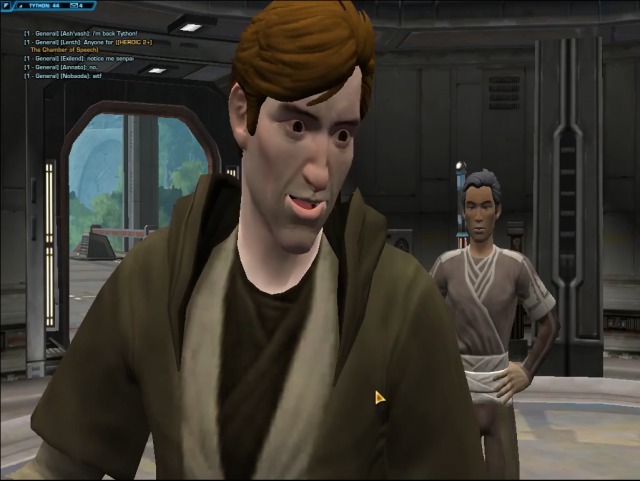
This wouldn’t be so bad, except the game continues to spam cutscenes at me, not allowing me to change the resolution or graphics settings for a good 15 minutes worth of cutscenes and character selections. As a result, I have to suffer through an extremely weird, stretched looking game for a quarter of an hour.
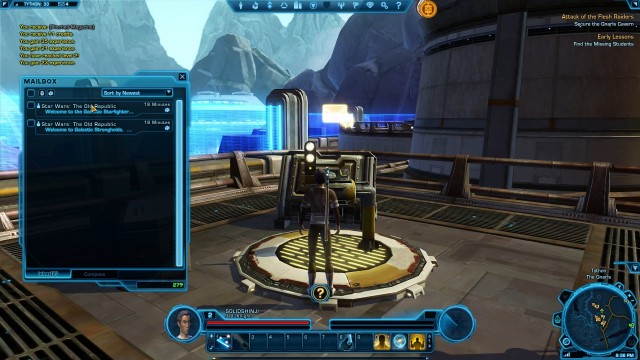
Here’s where the first truly stupid decision of TOR comes in. Because I chose to be a Jedi Knight, and Matthew chose to be a Republic Trooper, we start on completely different planets, and aren’t allowed to leave our planets until we finish off the main storyline on our respective starting planets, despite being on the same faction.
We played TOR on 3 different occasions, with a total playtime of about 7 hours. We never met up ingame.
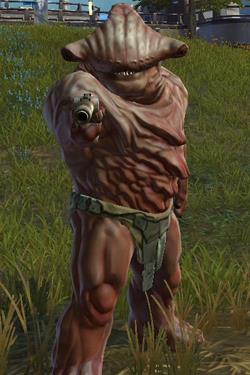
At any rate, in my story, the Jedi Knight, the game introduces us to the immediate threat — Flesh Raiders, who are supposedly threatening the once-safe training grounds of the Jedi Order. Unfortunately, once we arrive at the training grounds, we find…a rather hilarious visual image. There are a line of Jedi in front of a group of Flesh Raiders who endlessly respawn, charge up to the line of Jedi, and are instantly cut down.
This proceeds forever.
That’s right. The immediate mission of cutting down Flesh Raiders is hampered by the fact that if the Flesh Raiders make it up to the line of Jedi, you don’t get credit for the kill . You need to either get their attention before they charge, or cut them down before they make it, or the incredible threat to the Jedi, in the heart of their power in Tython, will be kill-stolen from you by invincible Jedi who can OHKO them.
The end result of this is you don’t feel any urgency whatsoever in this fight, and it doesn’t feel like we’re even slightly necessary in the defense of the Jedi. It feels more like a slow massacre of the Flesh Raider population, and indeed, this is what we will be doing over the next few hours.
Regardless, we are introduced to our first quest-dispensing NPC, who informs us that some padawans, or Jedi-in-training, have gone missing during the whole Flesh Raider attack. Now, as a game which prides itself on its story, almost every single quest has voice acting as well as cinematics, including basic motions on the part of the characters, and its generally decently done. In addition, there are dialogue choices that affect how your character interacts with the NPC during the voiced lines.
The unfortunate problem is they’re rather a waste of time 95% of the time. Unlike its predecessors, the traditional RPG’s, Knights of the Old Republic, which featured fairly unique quests where you actually could gain information, weasel NPC’s into helping you, or other variations of events, your dialogue choices are almost totally irrelevant. In the above picture, all three of the choices lead to the same thing, you’re merely choosing how much of a jerk you want your player character to be in his daily life — with no consequences to boot.
You don’t really have a penalty to being a massive jackass, no NPC will refuse to help you because you call them ugly (a fact I abused repeatedly throughout my playthrough), or in any way behave negatively to you being a jerk apart from occasionally protesting before continuing on. Furthermore, the quests assigned to you have nearly no significance. In Knights of the Old Republic, quests often involved finding out crucial information, featured twists and interesting bits of lore, and so on. Now, to be fair, there are a few quests in TOR that are like that, but the majority of them are really simple fetch quests and slay X enemy quests. This isn’t really unexpected for an MMO, but it gets supremely tiresome to watch a 3-minute cutscene with 2 opportunities to select a conversation option just to accept a quest to collect a group of Padawans, who are basically Jedi-in-training. As a result, the player is quickly tempted to skip the whole cutscene, rendering what I’m sure was thousands of dollars worth of development effort pointless.
Continuing on with the missions, we are presented with yet another insult to our intelligence — the Padawans themselves. Now, to be clear, these Padawans are Jedi-in-training, so I can forgive the lack of much combat ability, and even the idea of them being overwhelmed in an ambush is not completely out of the picture. Indeed, in Knights of the Old Republic, Bastila, a main Jedi of your party, is knocked out in a starship crash and then captured by an independent faction using specialized restraints to basically drug her and prevent her from using her powers.
This, however, is ridiculous. These Jedi are perfectly awake, unrestrained, and the primitive, unskilled Flesh Raiders are just milling around. Moreover, this isn’t a special technological cage, or anything of the sort. It literally appears to be a bunch of scrap metal and wooden planks bundled up around these padawans. These padawans have plenty of time to surprise their captors, and make a run for it.
These cages look pathetic enough that I’m fairly sure an untrained, non-athletic individual can get out by simply ducking their head, or something. I understand that from a gameplay standpoint they wanted us to do a rescue mission, but could we at least have had them knocked unconscious or something that doesn’t so blatantly remind me that the NPC’s are stupid? In addition, this suffers from something that is found in a few other MMO’s — once your quota of rescued Padawans is fulfilled, you no longer bother rescuing them. That guy up there? I’ve already finished my quota. I can’t rescue him. He’s just screwed.
This normally isn’t an issue in most MMO’s and I can ignore it, but TOR prides itself on its storyline immersion, and its just another of a series of minor points that break the immersion. In this regard, it ends up satisfying neither the storyline depth of an RPG, nor the quick, task-oriented gameplay of an MMO, and simply inherits the worst of both worlds.
After some more trekking, we make it to the Jedi Temple, the actual seat of the Jedi Order, where it seems that Jedi generally amble about and do anything at all *except* deal with the Flesh Raiders hanging around. They pretty much tell us to go do work around general odd jobs involving Twi’lek settlers, who were persecuted for some form of religious cult or something, landed on this planet, and promptly got pounced on by the natives. I think its all supposed to be a reference to the settling of the Americas, but the game never really goes anywhere interesting with this, so you can safely ignore most of it.
No, the real call of this section of the game is its when we get to really get into *gameplay* and start fighting enemies that aren’t completely pathetic. Unfortunately, this is where we get into something I’ve been holding off on – combat is boring. I realize that MMO’s don’t often carry the best combat systems in the universe, but its pretty bland even by those standards.
The way the Jedi Knight’s combat system works is fairly generic and standard — the more you whack things with normal attacks, the more your “Focus” meter goes up, which allows you to execute different moves with varying abilities. Its not fancy, but its the same system which has gotten many, many MMO’s through their own combat. You even get a nice little Force Jump ability which lets you pretty much warp into combat on your own terms with a nice little Focus boost to start off with. Should be fun, right? There’s just one problem.
It doesn’t work.
Unfortunately, the Knight suffers from several issues. The first is that the way to raise Focus is rather slow, you just keep wailing on enemies with basic attacks. The second is that the “special abilities”…just don’t feel very powerful. There’s a “high DPS” attack that does like 1.5 times a normal attacks damage. I have an AoE melee attack that I often build up to. However, there’s one problem. Its range…is pathetic. I can hit enemies *only* if they are right next to me, wailing against my face with a melee weapon.
Its just that uh…there are a lot of enemies with guns in this game. They don’t actually feel the need, shockingly enough, to walk into my AoE range when they could just as easily shoot me from where they stand.
Now, if you’re one of the few people left on this earth who isn’t aware of how Jedi work — they are sword-wielders in a world filled with laser rifles. This isn’t a problem they’re unaware of, canonically, in either film or game versions. And so, they have a solution to balance it — they’re capable of using their lightsabers to reflect incoming bullets either away from themselves, or back at their enemies. This is honestly one of the high points of good Star Wars games like the Star Wars: Jedi Knight franchise, where by simply standing around with your lightsaber on, you can deflect a lot of blaster fire back at your enemies, which means you don’t have to run over to each enemy and kill them.
In both Knights of the Old Republic, and Knights of the Old Republic II, the game has a “Deflection” skill that applies passively, allowing you to basically roll a check on each blaster bolt that’s about to hit you. If you roll higher than a certain number, you deflect it. If you roll *really* well, you reflect it back into the face of whoever shot you. Its a really good mechanic, that allows you to capture the feeling of being a Jedi who can stand against armies and win.
Now, the game starts you off with a vibroblade instead of a lightsaber, which is just basically a sharp sword that vibrates, presumably on the principle that if it works for shaving razors, it should do wonders in combat. You can get a training lightsaber as a drop, but its not a heck of a lot better than your blade, and it generally looks silly. The primary build up of the first planet of this game is the fact that you, and the character, are itching for your real lightsaber which will herald your acceptance into the ranks of the Jedi Order.
Now, I’ll give you, they do a good job of building you up to the point where you *want* that lightsaber. You’re looking forward to the combat boost you get, and the story is leading there, tantalizing you about three to four times where you almost get a lightsaber by slaying a dark Jedi, but its taken away from you, another time when you retrieve a fallen Jedi’s lightsaber, only to have it break, and generally you are in 100% agreement with the idea that you should have a lightsaber. So, you go through a heaping dose of plot involving the true villain of the first story arc, who turns out to be a fallen Jedi Padawan who brought the Jedi Order to its knees on its home planet. Its really quite hilarious, and generally cements the feeling that you’re the only competent Jedi in the whole planet, if not the galaxy, given that it wasn’t even their enemies who nearly took them out, but a former Padawan. I’ll spare the conclusion, given that this part of the plot is actually amusing and deserves to not be spoiled – the only section of the game so far that I feel deserves that honor.
However, once this section of the game is finished, you finally, FINALLY get your goddamned lightsaber, and get the chance to test it out in combat, to see the true might of the vaunted Jedi weaponry, to see the glory of…
The epic troll that you just got slammed by. Turns out, the lightsaber is a really minor stat boost compared to the weaponry you already have, on par with the upgrades you get when you get a new drop. And that wonderful ability to reflect blaster bolts back at your enemies? This game doesn’t have that. You pretty much deal with bullets by getting hit with them in the face. This is especially insulting considering that the games in the KOTOR series already had this mechanic. This wasn’t a new innovation I wanted, I just wanted to keep the ability we had in the older games — and it would have made dealing with enemies that shoot at us from range much less of a pain in the ass.
To be sure, there’s an animation that plays when you roll an evade against a bullet, but it doesn’t do anything back to your enemies, and you don’t have any higher evade roll than before – or any other character class in the game for that matter, you just get a different animation where you use your lightsaber instead of dodging with your body. It works really well — if the enemies you’re facing are about 10 levels below you. If you’re dealing with anything remotely on-level, expect to just get shot in the face.
This, again, means that dealing with enemies becomes a chore where you walk over to one, try to build up your focus, run over to the next guy who’s shooting you, and repeat. You can’t even use Jump to deal with this since its cooldown is too high to use it in the middle of combat too often. It adds up to combat being not very exciting, and the whole “gameplay” part of the game rapidly devolves into a chore. There are other games with similar mechanics, like the Champion in Lord of the Rings Online, but at least their AoE skills have decent enough ranges to handle most enemies, even including ranged enemies, with proper placement of your own position. This game doesn’t, and enjoys throwing you against enemies that have lots of range, rendering your enjoyment fairly low.
I was willing to tolerate it for the first few levels of the game, on the repeated, and futile justification that once I got a lightsaber, this game’s combat would finally become fun. However, once I got my lightsaber, and was served my plateful of utter disappointment, the whole Jedi Knight story for me lost interest, and I pretty much bailed on the planet, tried a few missions on Coruscant, and got bored. I actually did try the Republic Trooper storyline, but I’ll leave that bit for Matthew to explain.
Matthew:
Unlike my colleague who had the incredible misfortune of playing as a Jedi Knight, I chose to play as the venerable Republic Trooper – and aside from the common TOR issue of using cutscenes for every mission (which honestly cheapens the value of them, as they become an annoyance, rather than a flag that the mission you’re about to go on is important) – I had a good time.
I will say up front that I place less value in technical achievement and the look of a game – I frankly don’t care about graphics as long as they are above a certain threshold. Rather, I am more concerned with how a world feels – with design, consistency, and engagement. Does a game provide a compelling reason for your character to be doing what he or she is doing? Is what you are asked to do consistent with who your character is supposed to be and the setting you’re in?
And most of all – is the situation you’re in interesting at all?
As a Republic Trooper, you start on Ord Mantell, where your squad has tracked a stolen Republic bomb – essentially a nuclear device – with orders to locate and retrieve it before it can be used by the enemy. So far, so good – you have a purpose in being here, and while counter-terrorism is not the most creative hook in the world, it is a fairly effective one. It establishes a sense of urgency and establishes that your character – and what your character does – is important.
Of course, then your transport is shot down and disabled by enemy rockets, though only the pilot has been killed. Luckily, you and your squadmate survive, and since he’s the techie, he’s going to try and repair the transport, while you go in on foot, perform recon, and take out the missile battery that shot your vessel down.
The game goes from there, with most people recognizing you as good at what you do – or at least their only hope of getting help, which people will do when they are desperate. Even Separatist enemies – of which there are a good number, considering that your missions take you deep into enemy territory, aren’t terrible to fight.
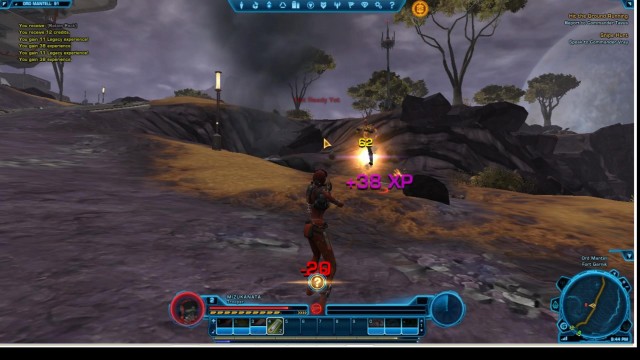
In fact, most go down like chumps – as they should when you are an elite trooper, and most of them have just been picked up from the civilian population, doped full of stims, and pressed into fighting. You get the distinct impression from conversations and missions that while Ord Mantell is a warzone, it’s not one where either side has much in the way of supplies, where neither side is well-regarded by the civilian population, and where, until you and your squad showed up, there was an utter stalemate.
I suppose what I am trying to say is that as a Trooper, it feels like there is some meaning for you being there – you have the power to change the situation. This empowerment of the protagonist is a staple of good games — the player should feel as if their contributions matter, because if they don’t, then what is the point of playing in the first place?
And more, unlike the Jedi Knight’s experience, this empowerment of the protagonist is justified. The Republic Trooper is an elite commando, newly arrived on a world torn apart by war, where the slightest bit of aid to one side or another could tip the balance; the Jedi Knight, on the other hand, starts as someone who hasn’t even been accepted as a Padawan on Tython, the supposed heart of the Jedi Order’s power, and yet is somehow outperforming Jedi Masters with decades of experience.
In that story, the attempt to empower the protagonist backfires horribly. Perhaps the writers intended for the character to be some glorious Chosen One – but you don’t feel that way. What you feel is that the entire Order – from Padawans to Jedi Masters – is utterly and atrociously incompetent, and that the villains who talk about it being weak and corrupt – and thus needing to be eliminated – are absolutely correct. After all, if an order of what are supposed to be badass warrior monks, who are legendary for their wisdom and martial prowess, are being overwhelmed by small bands of dumb unruly nomads in the heart of their power, then why hasn’t it already fallen to the Sith or other foes which actually matter? And worse, the sense of urgency the Jedi Knight story tries to instill clashes jarringly with what you see in-game, where nomad raids are repulsed viciously by three Jedi who pretty much kill anything they look at.
There is no need – for tactical or narrative reasons – for this Marty Stu impression of a overpowered Padawan, and the attempt to shoehorn the character falls flat on almost every level imaginable. That the depiction of the Order here throws out everything from KOTOR and KOTOR 2, where the Exile’s Disciples vowed to rebuild the Order as something strong and lasting is almost secondary compared to that.
Personally, I feel as if the Jedi Knight’s story would have been far better received if one was a Padawan on the cusp of their Knighthood Trials, dispatched to one of the warzones where tensions with the Empire (and the Sith) were high. This would have justified the player having some sort of narrative and tactical significance – as this would be the first time you are being forced to act without direct oversight from the Temple.
But on the note of narrative justification, one of the features touted as a strength – the use voiced cutscenes in place of “text-based stories” in older MMOs to facilitate immersion – actually backfires for two related reasons: 1) the use of cutscenes for otherwise meaningless fetch quests common to other MMOs in which backstory is not necessary; which directly leads to 2) the overabundance of cutscenes cheapening them as a whole.
And when 95% of a game’s cutscenes are skippable for how useless they are, you tend not to pay much attention to the other 5%, meaning that the shiny glorious story that cost hundreds of millions to put together and present is money down the drain. Such an approach also makes adding future story content both more difficult and more expensive – with the result being that in the two expansions to date: The Hutt Cartel and Shadow of Revan, there have been no additions to the vaunted Class Stories, simply a single storyline regardless of faction – and one that throws out everything done in the KOTOR series, to add insult to injury.
To make it worse, due to Free to Play limitations allowing one to play on a maximum of two characters – while of course, taking longer to level and paying more to unlock pretty much everything – with no ability to mail items or credits between characters, there is no incentive or motivation to try out multiple characters. For someone not willing to make an initial investment, time is best spent invested into leveling one character – perhaps one of each faction, if one wanted to be generous.
Which means that if one happens to make the wrong decision on what class to play, one is likely to get disgusted with the game, quit, and never look back.
End of story.
Look and Feel: For the most part, neither of us had too many complaints about the visuals of TOR. Sure, it isn’t as graphically beautiful as TERA (which came out about a year before it), but it would have been acceptable — if it hasn’t cost $300 million to create. Yes, we keep going back to that, but its a rather large point, if most people will never see the bulk of what that $300 million went to. There were also some quibbles with animation quality – middling at best, with some flaws one simply does not expect from a game of this budget – though to be fair, TOR is not the only large budget game that has disappointed in the last few years.
Gameplay: Two major issues were central to our experiences. First of all, disengaging and running away was never an option – one could simply not outrun enemies (or their fire) and would die if one tried. Secondly, if one stopped attacking, enemies quickly return to full health, meaning that the only viable strategy is simply try and kill things before you get killed. Not a great deal of variety, even if Trooper allowed you to have more options than Jedi Knight, which both of us found hilarious.
Stay tuned for our actual analysis of the game design, decisions, and where the game’s ambitions differed from player experience, coming next week!
